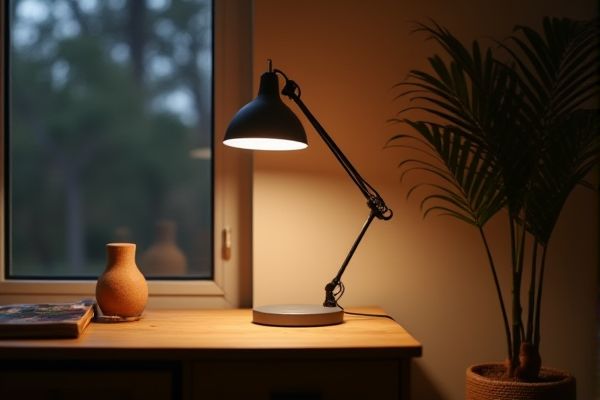
Task lamps provide focused, direct light designed to illuminate specific areas such as desks or workspaces, enhancing productivity and reducing eye strain. Ambient lamps offer soft, overall illumination that creates a comfortable atmosphere in a room; discover which lighting solution best suits Your needs by reading the rest of the article.
Table of Comparison
| Feature | Task Lamp | Ambient Lamp |
|---|---|---|
| Purpose | Focused lighting for specific tasks like reading or working | General, soft lighting to enhance room ambiance |
| Light Intensity | High brightness for clarity and detail | Low to medium brightness for mood setting |
| Light Direction | Adjustable and direct light beam | Diffused, spread light |
| Placement | Close to work area like desks or reading zones | Positioned around the room for overall illumination |
| Design | Functional, often with adjustable arms or heads | Decorative, blends with interior style |
| Usage Time | Used during focused activities | Used to create a cozy environment, often in evenings |
| Energy Consumption | Typically moderate to high due to intensity | Generally low energy usage |
Introduction to Task Lamps and Ambient Lamps
Task lamps provide focused, intense light designed for activities requiring precision, such as reading or detailed work, enhancing visual clarity and reducing eye strain. Ambient lamps offer softer, diffuse illumination that creates a comfortable atmosphere and balances overall room lighting without causing glare. Choosing the right lamp depends on your need for concentrated brightness or gentle background light to optimize both functionality and ambiance.
Defining Task Lighting: Key Features
Task lighting is designed to provide focused, bright illumination that enhances visibility for specific activities such as reading, writing, or detailed work. Key features include adjustable positioning, concentrated light beams, and reduced glare to minimize eye strain and improve precision. Your workspace benefits from task lamps by delivering targeted light exactly where it's needed, unlike ambient lamps, which offer general, diffused illumination for overall room brightness.
Understanding Ambient Lighting: Main Characteristics
Ambient lighting provides overall illumination that creates a comfortable and inviting atmosphere by evenly distributing light throughout a space. It minimizes shadows and glare, ensuring your room feels balanced and visually cohesive without focusing on specific areas. The primary function of ambient lamps is to set the mood and support other lighting layers, enhancing the general visibility in your environment.
Task Lamp Benefits for Focused Activities
Task lamps provide concentrated lighting designed to illuminate specific areas, enhancing visibility for detailed activities such as reading, writing, or crafting. Their adjustable brightness and positioning reduce eye strain and improve precision, making them ideal for workspaces and study environments. Unlike ambient lamps, task lamps optimize light distribution directly where it's needed, boosting productivity and focus.
Ambient Lamp Advantages for General Illumination
Ambient lamps provide broad, even lighting that illuminates an entire room, reducing shadows and creating a comfortable atmosphere. They enhance your space by establishing a balanced light level, which minimizes eye strain and improves overall visibility. Choosing ambient lighting supports a cohesive environment suitable for various activities without the harsh focus of task lamps.
Comparing Design Aesthetics: Task vs Ambient Lamps
Task lamps feature a focused, functional design often characterized by adjustable arms and directed light, ideal for precision activities like reading or working. Ambient lamps emphasize softer, diffused illumination with decorative elements that enhance a room's overall atmosphere rather than drawing attention to a specific task. Your choice between the two should consider whether you prioritize targeted light efficiency or a mood-enhancing, stylish ambiance in your space.
Energy Efficiency: Which Lamp Consumes Less?
Task lamps generally consume less energy than ambient lamps because they focus light on a specific area, reducing unnecessary illumination in the entire room. Energy-efficient LED task lamps use low wattage while providing bright, concentrated light ideal for workspaces, enhancing your productivity without increasing your energy bill. Ambient lamps often require higher wattage bulbs to evenly light an entire room, resulting in greater overall energy consumption.
Choosing the Right Lamp for Your Space
Task lamps provide focused, high-intensity light ideal for activities like reading, writing, or detailed work, enhancing productivity and reducing eye strain. Ambient lamps offer softer, broader illumination that creates a warm, inviting atmosphere, suitable for general room lighting and relaxation. Select a task lamp for workspaces demanding precision, while ambient lamps best serve living areas where comfort and mood lighting are priorities.
Common Mistakes When Selecting Lighting
Common mistakes when selecting lighting include choosing ambient lamps when task lamps are needed, which reduces focus and efficiency during close-up activities. You should avoid relying solely on overhead ambient lighting, as it can cause eye strain without providing sufficient illumination for detailed tasks. Understanding the specific lighting requirements for your workspace ensures better visual comfort and productivity.
Final Verdict: Task Lamp or Ambient Lamp?
A task lamp provides focused, bright light ideal for detailed activities like reading, writing, or crafting, enhancing your productivity and reducing eye strain. Ambient lamps offer softer, diffused lighting that creates a cozy atmosphere and complements overall room illumination without overpowering. Your choice depends on whether you need precise lighting for tasks or a gentle glow to set the mood.
 homyna.com
homyna.com